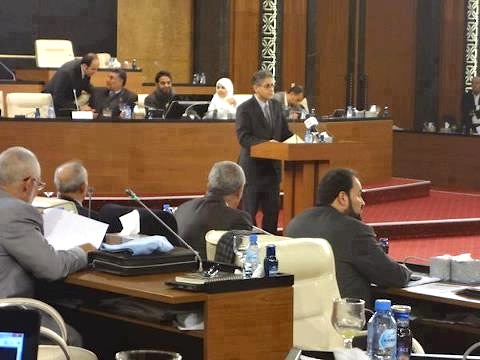By George Grant.

Tripoli, 11 December:
Activists working for greater female empowerment in Libya sent a powerful message yesterday, unveiling 34 murals on . . .[restrict]the walls of Bab Al-Azizya, Qaddafi’s former fortress compound and the most potent symbol of the former regime’s oppression.
The opening ceremony of the ‘Flame of Our Capital’ brought together local and international civil society activists, together with representatives of the British Government, which provided funding for the project.
Stretching for dozens of metres down one side of Bab Al-Azizya, the paintings convey a series of messages around the central theme that post-Qaddafi Libya should be a country of equal opportunity for men and women.
“These walls represented the oppression of the former regime, and we wanted to replace the bad feelings with positive messages about the revolution and its potential for Libya”, says project organiser Munib Al-Asabee, explaining the rationale for Flame of Our Capital’s location.
“Statistically, there are more women than men in this country, and their reinclusion in society is one of the most important steps in building the new Libya.”
He says the ultimate ambition is to cover the walls of Bab Al-Azizya with paintings on different themes stretching 500 metres, making it one of the longest murals in the world. According to the Guinness Book of Records, the biggest mural in the world at present is located in Dubai, stretching some 1,700 square metres on the roof of the 8th floor of the Sheikh Zayed Road hotel.
Entitled ‘Caravan of Women’ the Dubai mural represents the camel caravans which used to pass through the Arabian Peninsula desert with women on board, and is intended to honour mothers, wives, daughters and sisters.
Standing a short distance from Asabee are two sisters born and raised in Libya, who explain the meaning of their mural, a wide-eyed woman muted by masking tape strapped across her mouth.
“The woman in this picture has many things on her mind”, explains Yasmina Elmehdawi. “But she either doesn’t know how to express them, or she’s too afraid or not allowed, hence the tape on her mouth. She is painted in warm and cold colours, representing her mixed feelings.”
Asked if they believe this woman provides an accurate representation of women in Libya today, both sisters are categoric: “definitely”, says Wareda Elmehdawi, “95 per cent of Libyan women feel this way. They grew up in families where they are made to believe they should not have their own thoughts. And the men do not let them speak, so women fear for their rights.”
A little over half of the 43 artists involved in the project are women, but it is notable how many men have also taken part.
“We need to start talking about women in Libya”, says Anass Mohammed, who has painted a huge set of scales weighing the equality of males and females in society. “There is not too much equality in Libya”.
Asked how he thinks that can change, Mohammed says women need to be more included in the workplace and also in the social sphere.
“Ultimately, it will have to be young people who change this”, says Mohammed. “For sure, they are more tolerant than older people.” Asked how many of his male friends share his views on women, however, and Mohammed says no more than 30-40 per cent.
The organisation responsible for coordinating Flame of Our Capital is the international NGO DCA, a non-religious charity also heavily involved in demining work with the Libyan armed forces, as well as the local NGO Voice of Libyan Women.
“We are so pleased to have been able to support this campaign”, says DCA’s Lisa de la Rubia. “This is the first chance that women have had to paint on Bab Al-Azizya. The previous artworks were all done by men.”
De la Rubia says that Flame of Our Capital, whilst a Libyan project, is also plugged in with ‘16 Days of Activism’, a global campaign to stop violence against women.

Also present at the unveiling were the UK’s Foreign Office Minister for the Middle East and North Africa Alistair Burt and British Ambassador to Libya Michael Aron. With the British Government having provided LD 14,000 dinars for the project, Burt was invited to make his mark – literally – by clambering atop a scaffold and dipping his hands in yellow paint and imprinting them on the wall.
“On behalf of the British Government, I will like to say how very proud we are to have played a part in this”, Burt said. “The symbolism of these paintings matters a great deal. We’ve seen some powerful images, and to remind people that images such as this were illegal before the revolution sends a powerful message about Libya’s future.” [/restrict]








